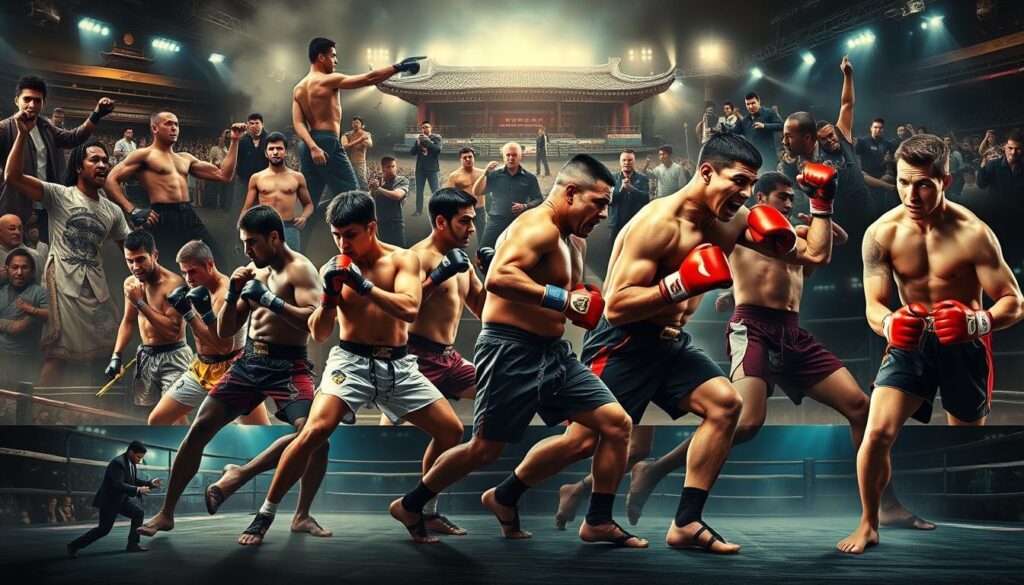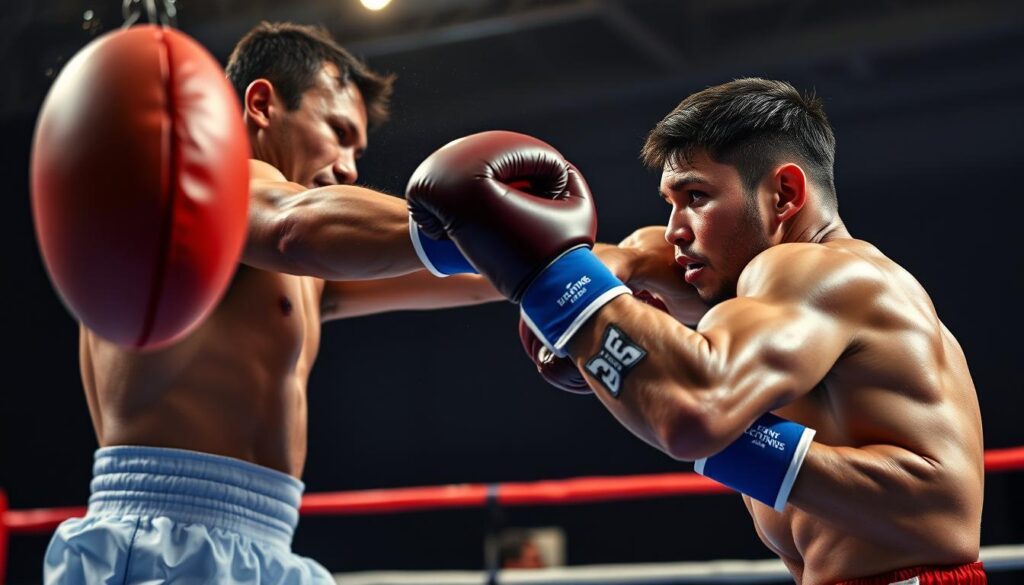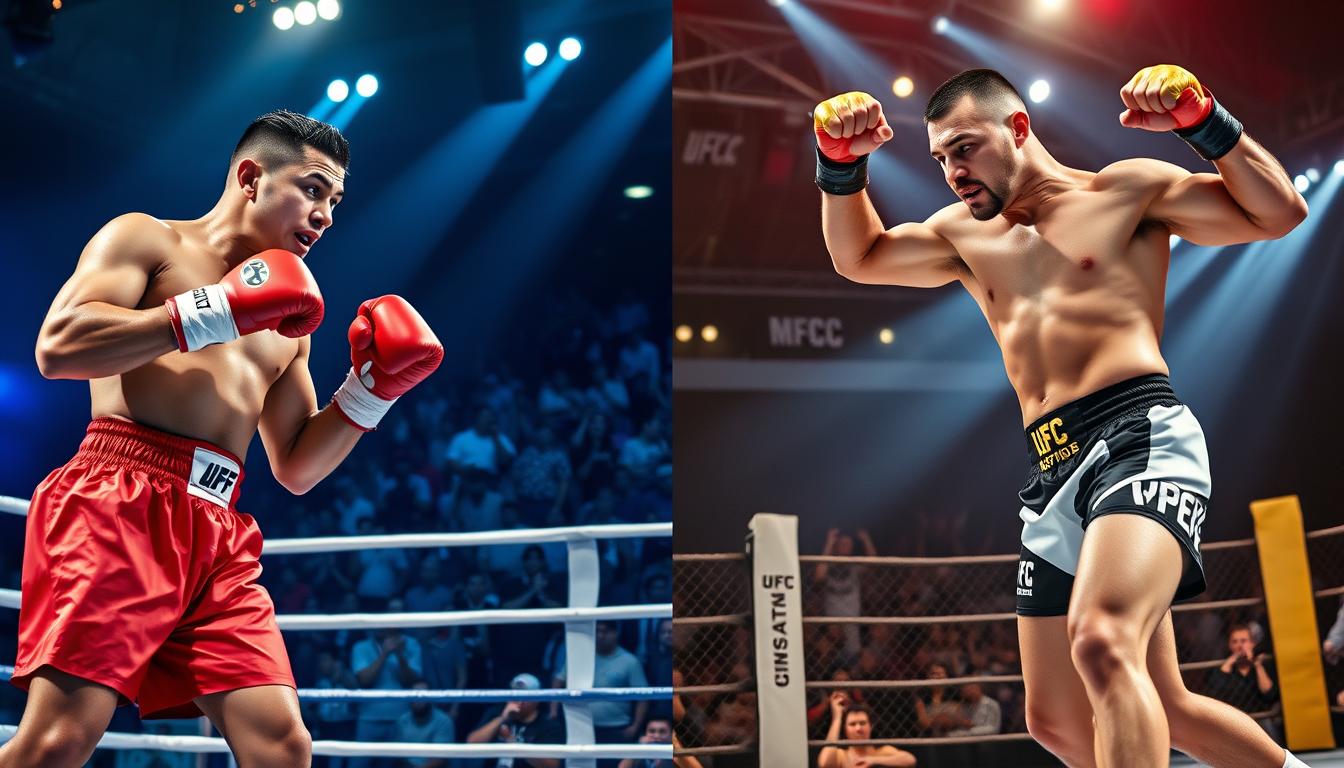The world of combat sports is full of excitement and complexity. Boxing and Mixed Martial Arts (MMA) are two top contenders, each with a history and fan base. MMA includes grappling and striking, while boxing focuses on punching.
Knowing the differences between boxing and MMA is key for fans and athletes. The gear used, like gloves and cages, is different too. As we explore combat sports, we see boxing and MMA differ in more ways than just techniques and equipment.
Key Takeaways
- Boxing and MMA have distinct fighting techniques, with MMA allowing a broader range of skills.
- The equipment used in each sport, such as gloves and cages, differs significantly.
- Combat sports, including boxing and MMA, have unique rules and regulations.
- Athletes in boxing and MMA require different training methods and physical conditioning.
- The career paths and earning potentials of athletes in boxing and MMA vary significantly.
- Understanding the differences between boxing and MMA is essential for fans, athletes, and promoters.
- Combat sports, including boxing and MMA, have a significant impact on the physical health and safety of athletes.
The Evolution of Combat Sports
Combat sports have a long and varied history. Boxing has roots in ancient Egypt, Greece, and Rome. Mixed martial arts (MMA) came later, combining different fighting styles into one sport.
Changes in culture and fan interest have shaped combat sports. New rules and disciplines have emerged. For example, the Marquess of Queensberry rules made boxing more formal in the 19th century. The Ultimate Fighting Championship (UFC) was founded in 1993, making MMA popular.

- Boxing debuted in the Olympic Games as early as 688 BC
- The first UFC event took place in 1993, blending various martial arts disciplines
- Brazilian Jiu-jitsu (BJJ) gained global popularity after dominating early UFC tournaments
The history of MMA is linked to martial arts like BJJ, Muay Thai, and wrestling. It’s exciting to see how these sports will evolve.
Combat sports are more than just entertainment. Athletes use their platforms to talk about important issues and promote equality. As the sport grows, it’s key to focus on athlete health and the values of respect and sportsmanship.
Understanding the Fundamental Differences
The combat sports world is full of variety, with each sport giving athletes and fans unique experiences. Boxing and MMA stand out because of their distinct approaches. Boxing has a long history, focusing mainly on punches. MMA, on the other hand, includes a wide range of techniques like grappling and submissions.
The rules of each sport are also different. Boxing only allows punches to the front of the opponent’s body. MMA, though, allows punches, kicks, elbows, and knees to most body parts, except the groin and spine.
These differences greatly affect how athletes train and strategize in each sport.
Some key differences between boxing and MMA are:
- Allowed techniques: Boxing is all about punching, while MMA includes punching, kicking, elbowing, and grappling.
- Scoring system: Boxing uses the ten-point must system. MMA scores rounds based on who had the clear advantage, awarding 10-9.
- Ring or cage: Boxing fights happen in a ring, while MMA takes place in an octagon-shaped cage.

Athletes, coaches, and fans need to understand these differences. By knowing the unique boxing techniques and MMA techniques, we can better appreciate the skills and strategies in each sport.
| Sport | Allowed Techniques | Scoring System |
|---|---|---|
| Boxing | Punching | Ten-point must system |
| MMA | Punching, kicking, elbowing, grappling | 10-9 for a round with a clear advantage |
Boxing vs. MMA: A Technical Breakdown
Boxing and MMA have their fighting styles. Boxing focuses on punches, while MMA includes grappling and kicks. Fighters must adjust their plans based on the fight’s style.
MMA fighters often take the fight to the ground, using holds to control their opponents. Boxing, on the other hand, focuses on keeping a safe distance. Boxers use footwork to dodge punches and aim for close-range hits like hooks.
Knowing the differences in fighting styles is key for fighters moving from boxing to MMA. While some boxing skills can help in MMA, others might put fighters at risk. By adjusting their techniques, fighters can do well in their chosen sport.
Striking Techniques Comparison
Boxing and MMA striking styles are quite different. Boxing is all about precise punches, speed, and agility. MMA, on the other hand, includes kicks, knees, and elbows in its arsenal.
Ground Game Analysis
The ground game is vital in MMA, where fighters need to know many submission holds and positions. In boxing, staying at a distance and using footwork to avoid punches is the main goal.
Combat Range and Distance Management
Managing distance is key in both boxing and MMA. Fighters must adjust their tactics based on the fight’s range. They use footwork, punches, and grappling to outmaneuver their opponents.
Training Methods and Requirements
Boxing and MMA have different training methods. Boxing focuses on punching, footwork, and getting in shape. MMA, on the other hand, includes wrestling, Brazilian jiu-jitsu, and Muay Thai. Both sports need great physical shape, with a focus on heart health, strength, and quickness.
Boxing training uses sparring, shadowboxing, and drilling techniques to boost hand-eye coordination and speed. MMA training, by contrast, teaches various striking techniques and grappling techniques like takedowns and submissions.
Key Training Components
- Cardiovascular endurance: essential for both boxing and MMA
- Strength training: key for power and speed
- Flexibility and agility: needed for fast movements and quick reactions
- Technical skills: specific to each sport, such as punching techniques in boxing or submission holds in MMA
Getting in shape is vital for both sports. It’s about building endurance, strength, and agility. By using different training methods, boxers and MMA fighters can get better and reach their goals.
Comparison of Training Requirements
| Sport | Training Methods | Physical Conditioning |
|---|---|---|
| Boxing | Sparring, shadowboxing, drilling techniques | Cardiovascular endurance, strength training |
| MMA | Striking techniques, grappling techniques, conditioning exercises | Cardiovascular endurance, strength training, flexibility and agility |
Knowing the unique training needs of each sport helps athletes focus their training. Whether in boxing or MMA, a good training plan is key. It helps athletes get in top shape and master the skills needed to succeed.
Rule Sets and Competition Formats
Combat sports have their own rule sets that guide how fights are held. Boxing fights take place in a ring with ropes. MMA battles happen in a cage or octagon. The competition formats of these sports differ greatly.
Boxing matches last from 3 to 12 rounds, with each round lasting 3 minutes. They use the ten-point must-scoring system. MMA fights, on the other hand, are divided into 3 rounds of 5 minutes each. Championship fights can extend to 5 rounds.
MMA’s scoring system is more detailed. It considers effective striking, grappling, aggression, and cage control. Weight classes in MMA add organization, with fighters competing in different weight categories.
The boxing rules are strict, with penalties for too much holding or grappling. This highlights a focus on stand-up striking. MMA, however, allows fighters to use techniques from various martial arts. This makes MMA more versatile and dynamic.
The rule sets and competition formats of these sports have evolved. The Ultimate Fighting Championship (UFC) introduced a unified set of rules in 2000. This was to make MMA safer and more structured.
Key differences between the two sports include:
- Scoring systems: boxing uses the ten-point scoring system, while MMA uses a more complex system considering multiple factors.
- Competition formats: boxing matches consist of 3 to 12 rounds, while MMA fights typically consist of 3 to 5 rounds.
- Equipment: boxing gloves can weigh up to 16 ounces, while MMA gloves typically weigh 4 ounces.
Professional Career Paths and Opportunities
Combat sports open doors for athletes, coaches, and professionals. Boxers like Canelo Alvarez and Floyd Mayweather can make tens of millions per fight. However, lower-ranked boxers might struggle to make ends meet.
The promotional systems in MMA, like the UFC, give fighters a chance to show their skills. They can earn millions through PPV shares and bonuses.
The earnings for MMA fighters vary a lot. It depends on fight purses, bonuses, and PPV shares. Amateur success can lead to big contracts with major organizations. Professional wrestling offers creative freedom and chances for independent promotions.
Coaches, sports managers, and promoters are key in shaping athletes’ careers. They need skilled professionals in nutrition, physical therapy, and sports law.
- Establishing a strong brand and public persona to secure lucrative sponsorship opportunities
- Developing skills in areas such as entertainment and character portrayal for professional wrestling
- Understanding the rules and making quick decisions as a referee or official
- Providing specialized services such as legal representation and contract negotiation for combat athletes
| Combat Sport | Career Path | Earnings |
|---|---|---|
| Boxing | Amateur to professional | Tens of millions per fight |
| MMA | Amateur to professional | Millions through PPV shares and bonuses |
| Professional Wrestling | Independent promotions | Varies depending on promotion and performance |
Impact on Physical Health and Safety
Combat sports like boxing and MMA come with big risks for athletes. Injury risk is a major concern, with studies showing 59.4% of MMA fighters and 49.8% of boxers getting hurt during fights.
Medical screenings and safety rules are crucial to keep athletes safe. These include pre-flight checks and emergency plans for injuries. The goal is to avoid long-term health problems like pugilistic dementia, caused by head trauma.
Some important stats show the dangers of these sports:
- 7.1% of boxers get knocked out or lose consciousness during fights
- 4.2% of MMA fighters experience knockouts or loss of consciousness
- Boxers face more concussions, head injuries, and eye injuries. MMA fighters are more likely to get sprains, fractures, and cuts
Despite the risks, boxing and MMA are working to make things safer. For example, boxing’s 3-knockdown rule has cut down on knockouts and injuries. MMA has also set rules to prevent too much violence and protect fighters.
Cultural Influence and Global Appeal
The world of combat sports has changed a lot over time. Both boxing and MMA have made a big impact globally. Their global appeal comes from reaching people all over the world.
Boxing has a long history that has shaped popular culture. MMA, on the other hand, has become a hit with a new crowd. The media coverage of these sports has helped them become big deals. Major fights are shown everywhere, reaching millions.
Some interesting facts about MMA’s global appeal include:
- More than 14% of kids at Gracie PAC MMA are under 5, showing early interest.
- Over 90% of students feel welcome and included right away, thanks to a great start.
- More than 75% of parents see their kids grow in character, confidence, and social skills at Gracie PAC.
The media coverage of MMA, like UFC events, has boosted its global appeal. UFC’s unique fan experiences have made MMA a big sport worldwide.
| Sport | Global Reach | Media Coverage |
|---|---|---|
| Boxing | Traditional strongholds in the US and Europe | Established media presence, with major events broadcasted worldwide |
| MMA | Rapidly expanding global fan base, with a strong presence in the US, Europe, and Asia | Growing media coverage, with major events and fights being broadcasted worldwide |
Crossover Athletes and Notable Transitions
Crossover athletes are becoming more common in combat sports. Many fighters switch from boxing to MMA. For example, Conor McGregor’s fight against Floyd Mayweather Jr. drew a lot of attention and made a lot of money.
Holly Holm is another great example. She moved from boxing to MMA and did very well. This shows that athletes can do well in different sports.
Some famous crossover athletes include Alistair Overeem and Brock Lesnar. Overeem went from kickboxing to MMA, and Lesnar moved from MMA to the NFL. Their success shows that hard work can lead to success in different sports.
The move from MMA to boxing has also made combat sports more interesting. It has increased viewership and engagement in both sports.
- Charlie Powell, who had a successful career in both boxing and the NFL
- Anthony Mundine, who transitioned from rugby league to boxing and won multiple titles
- Herschel Walker, who competed in MMA at age 47 and won his debut match via TKO
These examples show that athletes can succeed in many sports. They highlight the growing trend of crossover athletes in combat sports.
The Business of Combat Sports
Combat sports are a big deal, with many ways to make money. Promoters use broadcasting rights, media partnerships, and sponsorships to draw fans. This helps them earn income.
Companies like the Ultimate Fighting Championship (UFC) and ONE Championship lead the field. They make money through pay-per-view, ticket sales, and merchandise. The UFC is worth $10 billion, and ONE Championship is worth $1.4 billion.
Key Revenue Streams
- Broadcasting rights: Securing lucrative deals with television networks and streaming services to broadcast events.
- Sponsorship deals: Partnering with brands to promote their products and services.
- Ticket sales: Generating revenue from live event ticket sales.
Good marketing is key to growing combat sports. Social media helps fighters and organizations connect with fans. The fight for broadcasting rights is fierce, with many wanting to show these events to more people.
Future Trends and Evolution
The world of combat sports is always changing. New tech and training methods keep popping up. We’re likely to see more tech in training and fights. For example, fitness wearables and recovery methods like cryotherapy are getting popular.
There’s a big shift towards a more complete training approach. Fighters are mixing different styles and disciplines. This is why MMA is getting more popular. It needs a wide range of skills.
- 70% of athletes use wearable devices for tracking and recovery.
- 50% of fighters use advanced recovery methods in their training.
- 60% of fighters focus on mental health, like mindfulness and coaching.
These trends highlight a focus on tech, recovery, and mental health. It’s exciting to see how these changes will shape combat sports in the future.
Frequently Asked Questions
What are the future trends and evolution of combat sports?
The future of combat sports might include new technologies and training methods. This could lead to more advancements and innovation in the sport.
What are the main differences between boxing and MMA?
MMA lets fighters use many techniques, like grappling and striking. Boxing, on the other hand, focuses only on punching. The gear used, like gloves and cages, also differs.
How have combat sports evolved?
Combat sports have a long history, with boxing dating back to ancient times. MMA, which combines different martial arts, has become popular more recently.
What are the fundamental techniques used in boxing and MMA?
Boxing mainly uses punching techniques. MMA, by contrast, includes a wide range of techniques, like grappling and submission holds, along with striking.
How do the technical aspects of boxing and MMA differ?
Boxing and MMA differ in their striking techniques and the importance of the ground game. They also differ in how fighters manage combat range and distance.
What are the training requirements and physical conditioning differences between boxing and MMA?
Boxing training focuses on the basics of the sport. MMA training, on the other hand, requires a broader range of skills and physical conditioning. The physical conditioning needed for each sport also varies, with cardiovascular endurance and strength training being key.
How do the rule sets and competition formats differ between boxing and MMA?
Boxing and MMA have different rules and competition formats. Boxing uses ropes and corners, while MMA has cages and submission holds. The scoring and match duration also differ.
What are the career paths and earning potentials in boxing and MMA?
Boxing and MMA have different career paths and how much money fighters can make. Each sport has its own promotional systems and revenue models. The earnings vary.
How do boxing and MMA impact physical health and safety?
Both sports come with injury risks and long-term health issues. To keep fighters safety, rules and safety measures have been set up.
What is the cultural influence and global appeal of boxing and MMA?
Boxing has a long history, while MMA has become more popular lately. Media coverage and fan interest are crucial for their global appeal.
What are the notable crossover athletes and transitions between boxing and MMA?
Some fighters have competed in both boxing and MMA. They face challenges and opportunities when switching between the two.
What are the business aspects of combat sports?
Combat sports involve revenue models, marketing strategies, and broadcasting rights. These factors greatly affect the growth and promotion of these sports.
Conclusion: The Verdict on Boxing vs. MMA
Boxing and mixed martial arts (MMA) are both unique in their ways. MMA combines striking, grappling, and wrestling, making it unpredictable. On the other hand, boxing focuses on punching and has a rich history.
Choosing between boxing and MMA depends on what you enjoy watching. Boxing is known for its long fights and heavy gloves, focusing on strategy and endurance. MMA, with its shorter fights and lighter gloves, values fighters who can do it all.
In the end, boxing and MMA are two sides of the same coin. They offer different experiences to fans of combat sports. As combat sports evolve, we’ll see more overlap between these two exciting disciplines.


